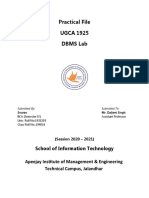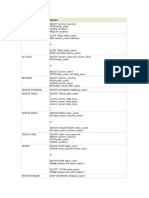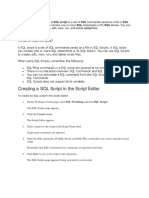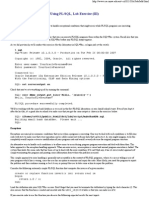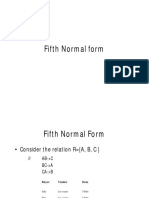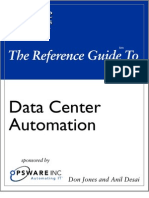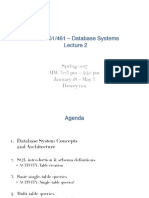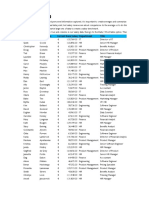SQL Overview
Uploaded by
kspSQL Overview
Uploaded by
kspSQL - OVERVIEW
http://www.tutorialspoint.com/sql/sql-overview.htm
Copyright tutorialspoint.com
SQL tutorial gives unique learning on Structured Query Language and it helps to make practice
on SQL commands which provides immediate results. SQL is a language of database, it includes
database creation, deletion, fetching rows and modifying rows etc.
SQL is an ANSI AmericanNationalStandardsInstitute standard but there are many different versions of the
SQL language.
What is SQL?
SQL is Structured Query Language, which is a computer language for storing, manipulating and
retrieving data stored in relational database.
SQL is the standard language for Relation Database System. All relational database management
systems like MySQL, MS Access, Oracle, Sybase, Informix, postgres and SQL Server use SQL as
standard database language.
Also, they are using different dialects, such as:
MS SQL Server using T-SQL,
Oracle using PL/SQL,
MS Access version of SQL is called JET SQL nativeformat etc.
Why SQL?
Allows users to access data in relational database management systems.
Allows users to describe the data.
Allows users to define the data in database and manipulate that data.
Allows to embed within other languages using SQL modules, libraries & pre-compilers.
Allows users to create and drop databases and tables.
Allows users to create view, stored procedure, functions in a database.
Allows users to set permissions on tables, procedures, and views
History:
1970 -- Dr. Edgar F. "Ted" Codd of IBM is known as the father of relational databases. He
described a relational model for databases.
1974 -- Structured Query Language appeared.
1978 -- IBM worked to develop Codd's ideas and released a product named System/R.
1986 -- IBM developed the first prototype of relational database and standardized by ANSI.
The first relational database was released by Relational Software and its later becoming
Oracle.
SQL Process:
When you are executing an SQL command for any RDBMS, the system determines the best way to
carry out your request and SQL engine figures out how to interpret the task.
There are various components included in the process. These components are Query Dispatcher,
Optimization Engines, Classic Query Engine and SQL Query Engine, etc. Classic query engine
handles all non-SQL queries but SQL query engine won't handle logical files.
Following is a simple diagram showing SQL Architecture:
SQL Commands:
The standard SQL commands to interact with relational databases are CREATE, SELECT, INSERT,
UPDATE, DELETE and DROP. These commands can be classified into groups based on their nature:
DDL - Data Definition Language:
Command
Description
CREATE
Creates a new table, a view of a table, or other object in database
ALTER
Modifies an existing database object, such as a table.
DROP
Deletes an entire table, a view of a table or other object in the
database.
DML - Data Manipulation Language:
Command
Description
SELECT
Retrieves certain records from one or more
tables
INSERT
Creates a record
UPDATE
Modifies records
DELETE
Deletes records
DCL - Data Control Language:
Command
Description
GRANT
Gives a privilege to user
REVOKE
Takes back privileges granted from user
Loading [MathJax]/jax/output/HTML-CSS/jax.js
You might also like
- Data Analysis With SQL: Mysql Cheat SheetNo ratings yetData Analysis With SQL: Mysql Cheat Sheet4 pages
- Oracle 11 G (SQL) : Quality Thought TechnologiesNo ratings yetOracle 11 G (SQL) : Quality Thought Technologies127 pages
- Gcse Information and Communication TechnologyNo ratings yetGcse Information and Communication Technology19 pages
- Power-Bi Interview Questions and AnswersNo ratings yetPower-Bi Interview Questions and Answers11 pages
- Chapter 27-OOP Questions: Mr. Mahmoud Moussa A2 CS 9618No ratings yetChapter 27-OOP Questions: Mr. Mahmoud Moussa A2 CS 961810 pages
- Interface Python With SQL Database: Apurv GuptaNo ratings yetInterface Python With SQL Database: Apurv Gupta20 pages
- Types of Triggers: Create INT Identity Varchar DecimalNo ratings yetTypes of Triggers: Create INT Identity Varchar Decimal6 pages
- Unit 1: Understanding Ict: A.M. FRIDAY, 13 January 2012 1 HoursNo ratings yetUnit 1: Understanding Ict: A.M. FRIDAY, 13 January 2012 1 Hours20 pages
- Image Processing - Using Machine Learning: Software Requirement SpecificationNo ratings yetImage Processing - Using Machine Learning: Software Requirement Specification19 pages
- PHP File Handling: Reading From Files With PHP FunctionNo ratings yetPHP File Handling: Reading From Files With PHP Function13 pages
- E-Business CIA-3 Research Based Assignment: ArticleNo ratings yetE-Business CIA-3 Research Based Assignment: Article4 pages
- Business Analysis CIA-3 Research Based Assignment: ArticleNo ratings yetBusiness Analysis CIA-3 Research Based Assignment: Article3 pages
- Database Management System: Important Questions Unit-1No ratings yetDatabase Management System: Important Questions Unit-19 pages
- Chapter 3 Relational Database - Logical DesignNo ratings yetChapter 3 Relational Database - Logical Design44 pages
- Creating A Database Backup in SQL Server 2012No ratings yetCreating A Database Backup in SQL Server 201216 pages
- Chapter 12: Big Data, Datawarehouse, and Business Intelligence SystemsNo ratings yetChapter 12: Big Data, Datawarehouse, and Business Intelligence Systems16 pages
- Lesson Plan: Sub Code & Name: Unit: I Branch: M.E (CS) SemesterNo ratings yetLesson Plan: Sub Code & Name: Unit: I Branch: M.E (CS) Semester7 pages
- Murachs SQL Server 2016 For Developers TOCNo ratings yetMurachs SQL Server 2016 For Developers TOC10 pages
- MCS 034 Previous Year Question Papers by IgnouassignmentguruNo ratings yetMCS 034 Previous Year Question Papers by Ignouassignmentguru49 pages
- Specialised Programme On Big Data AnalyticsNo ratings yetSpecialised Programme On Big Data Analytics3 pages
- Renormalization of Nosql Database Schemas: Michael J. Mior, Kenneth SalemNo ratings yetRenormalization of Nosql Database Schemas: Michael J. Mior, Kenneth Salem14 pages












